Ocean Avatar
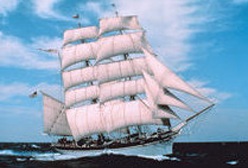
ELISSA
An Iron Barque of 1877
The Finest Restoration
“For
nearly three
decades, the 1877 sailing ship Elissa has been widely recognized as one
of the
finest maritime preservation projects in the world.
Unlike some tall ships of today, the Elissa
is not a replica but an authentic survivor from the Age of Sail. Over
her
century long commercial history, she carried cargos to ports around the
world
for a succession of owners. Her
working
life as a freighter came to an end in Piraeus, Greece where she was
rescued
from the salvage yard by a variety of ship preservationists who refused
to let
her die. The story
of Elissa’s discovery
and restoration by the Galveston Historical Foundation is nothing short
of
miraculous.” – Kurt Voss ‘Galveston’s the ELISSA – The Tall Ship of
Texas’ (Arcadia
Publishing).
Growing
up in
Annapolis in the 1950’s, Saturday mornings sailing the wooden Naval
Academy
yawls, canoeing in
college creek after
school, looking out over the harbor at the oyster draggers drying their
sails,
I thought the fishing fleets of the world still worked under sail. I couldn’t decide if I
wanted to be a
harpooner like the ones in Moby Dick
or follow in the wake of that moment’s hero, Irving Johnson as he
circumnavigated his Yankee for National Geographic.
Serving
an
apprenticeship in a small Connecticut shipyard, and another building
musical
instruments in Rhode Island, I eventually ‘found a home’, as sailors
say, at South
Street Seaport Museum in New York,
simultaneously a carpenter on the big ships: WAVERTREE and PEKING, and
curating
the Museum’s model collection. Rigging restaurants between ships and
maritime
museums I carpetbagged the concept of historic ship restoration to
Galveston,
Texas. The idea
caught fire and I found
myself at the head of a rescue crew of volunteers off to Piraeus,
Greece picking
up the ELISSA torch from Peter Throckmorton and Karl Kortum. Now restored as leading
light of the Texas Seaport Museum, new generations carry on her
traditions. According
to Peter Stanford,
president emeritus of the National Maritime Historical Society:
“Indeed, the
restoration of this graceful barque of 1877 is reckoned by many to be
the
finest restoration of an active sailing ship extant.”
From
Texas to
Mexico – a newly passed captain taking a break from ELISSA, swimming in
the turquoise
Caribbean in front of the pre-Columbian Castillo at Tulum, the maritime
historian in me asks, “Why is this building here; so precariously
perched on
cliff’s edge?” The
search for an answer
results in my first National Geographic grant
for an investigation by Pilar Luna and her team from the National
Institute of
Anthropology and History (INAH) and subsequent documentation by the Discovery & History Channels. Tulum
turns out to be the oldest, most sophisticated lighthouse in the
Americas.
And
now, pitched
up on the Arabian Peninsula in the UAE, observing how perhaps the last
dhows
for the East African Trade are a building.
And why is Wadi Hiluw so special? Does the topography produce a
Bernoulli Effect that fanned the flames for the Copper Age? Always the
‘how’
and the ‘why’. Can’t stop asking
now…

AVATARA
A Future History
“Do you know
about the Hindu concept of the Avatar?”
“A little,
tell me more.”
“Well, every
five to seven hundred years some self-realized being comes along to kick
humankind up to the next spiritual level.
A new religion usually grows up around each succeeding Avatar. Their vision replaces the old values. The new sect spreads, matures, undergoes
transformations, until the former True Religion is replaced by the new. Then it too grows old, atrophies and becomes
less and less relevant as humanity evolves - until the appearance of the next
Avatar.
Krishna, the
Buddha, perhaps Confucius, certainly the Christ, and maybe Mohammed are all
separated by the magic five to seven hundred year cycle. We seem to be missing an Avatar for the 15th
century. Was it Leonardo or St. Francis?
We are due for another One just about now.
Only this
time, perhaps for the first time, the ‘Avatara’ is a woman. Not one woman, or two, but three. This is their story…
The World:
Imagine
a world in which ‘progress’ is more about choice than an irresistible force.
The
Once upon a time… there was an American President with
a soft spot in his heart for the
They
elected their own Queens, Kings, Chiefs and councils whose first and principal
task was to sift through their legends and histories for the best qualities
inherent in the Hawaiian people; and decide whether and how to preserve these
characteristics. How could they maintain the indomitable warrior spirit that
inspired the greatest voyages in human history without war and avoid the over
exploitation of limited resources that led to starvation and cannibalism? And
to select from the modern world those things worth keeping – from direct
democracy in local matters, to keeping food cold without electricity.
The Girls:
Evolution
is not only the slow, seemingly random combination of genes and adaptations,
there is Cultural Evolution as well.
Every race gets what it deserves from preceding generations. Leadership
is a direct result of their society’s values. The Islanders’ search for their
past was aided by Lelani, a royal, whose prodigious memory was enhanced by
genetic recall of the women in her line going back a thousand years.
She
joins an Island-sponsored sail training and research vessel, the TUSITALA II,
to learn about the flooding world, and to rediscover traditional Island
Navigation that helped her ancestors populate the Pacific – a variation of
which provides their power guiding the commercial shipping in a modern world
suffering from energy shortages, hunger and political unrest. The entire planet
is convulsed by cataclysmic weather affecting celestial navigation. A ‘small nuclear accident’ wipes out nearly
all the satellites significantly altering communications and trade.
Aboard
the TUSITALA II, Lani forms a special relationship with Franci, a minor chief’s
daughter from the worldlier island
This
is their story from just a little ways into the future. This future is not so
far away…In fact, it starts now!

The
Secret of TULUM
Tulum may have
served as a port city for the Maya site of Coba as there is a sacbe road connecting the two. However, it was more
likely a principal way
station along a Putun Maya ocean trade route stretching from
Tulum’s
location to the Southwest of the principal
Putun entrepot of
The Secret
of Tulum was
rediscovered in 1982 by amateur nautical
archaeologist Michael Creamer. In
1984, representing
the Institute of Nautical Archaeology (INA) he
joined an expedition led by Pilar Luna of
Mexico’s National Institute of Anthropology’s Nautical Archaeology and
History
(INAH) funded by a grant from National
Geographic. Professor Luna’s team conducted experiments that
conclusively
proved Tulum’s El Castillo served as an aid navigating the narrow gap
in the
offshore coral reef (Fig. 3) that protects Tulum’s convenient landing
beach
(Fig 2). The
experiments were later
successfully repeated on several occasions and documented on film for Arthur C. Clarke’s Mysterious Universe –‘The
Mysterious Maya for Discovery
Channel’
(English)
www.youtube.com/watch?v=JWCIZoD0VvU,
and History
Channel (Spanish)
www.youtube.com/watch?v=OMo0Wri2-zw.
How does the
oldest lighthouse in the
The day
signals are a pair
of windows in the first floor stone work on either side of
the main tower. During daylight hours, the sky is visible through them
from
beyond the reef opening. As
long as the
Windows appear of uniform width the approaching vessel is within the
safe
channel. If one window appears to be reduced in width, the vessel’s
course must
be altered towards the narrowing window or it will come to grief on the
reef or
one of the several coral heads on either side of the channel within the
reef
confines.
The night
signals are two
windows situated in the upper floor of the
Castillo tower (Fig 5). The South Window measures about 45cm x 45cm and
projects a light beam wider than the safe reef opening.
The North Window, slightly taller and
narrower projects a light beam exactly the width of the reef opening
(Fig. 6). When
one sees the single light from the South
Window from offshore of the reef, it is time to ‘Get
ready!’ When
light from
the North window becomes visible, ‘Get
set!’ The
moment both lights are
equally brilliant; GO! As with the Day Signals, due
to the thickness
of the stone walls through which the light beams are projected, the
beam of light
decreases and increases as one deviates from, or returns to the main
channel –
very sophisticated indeed!
The Putun
Maya ocean going canoes of the Post Classic
period had raised bows and sterns (Fig 7 after
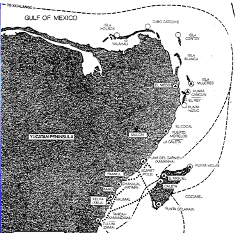
Tulum Landing Beach
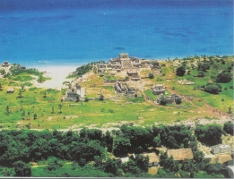 Fig. 2
Luis Gomez
Fig. 2
Luis GomezTulum Reef Passage
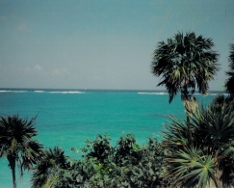
El Castillo Lights at Sunset

South & North
Castillo Light Windows
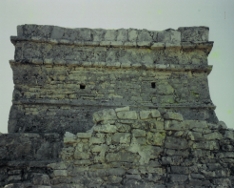
El Castillo Range Lights
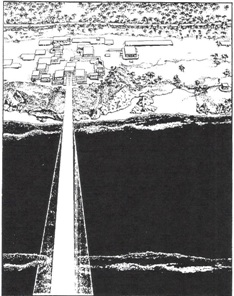
Classic Maya Canoes
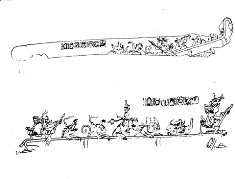
Maya Canoe from Chichen Itza
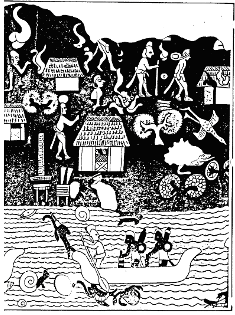
Fig 8. After Morris